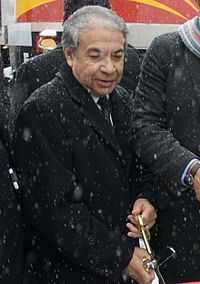Toney Anaya
| Toney Anaya | |
|---|---|
 | |
| Anaya at a 2008 ribbon-cutting | |
| 26th Governor of New Mexico | |
| In office January 1, 1983 – January 1, 1987 | |
| Lieutenant | Mike Runnels |
| Preceded by | Bruce King |
| Succeeded by | Garrey Carruthers |
| 24th Attorney General of New Mexico | |
| In office 1975–1978 | |
| Preceded by | David L. Norvell |
| Succeeded by | Jeff Bingaman |
| Personal details | |
| Born | April 29, 1941 Moriarty, New Mexico |
| Political party | Democratic |
| Profession | Politician |
Toney Anaya (born April 29, 1941) is a U.S. Democratic politician who served as the 26th Governor of New Mexico from 1983 to 1987.
Early life and career
Anaya was born in 1941 in Moriarty, New Mexico. He went to undergraduate school at Georgetown University and graduated with a law degree from American University's Washington College of Law in 1967. After returning to New Mexico, Governor Anaya worked as a Santa Fe County attorney, was an assistant district attorney for the First Judicial District, and later established a private law practice in Santa Fe.
Political career
From 1975 to 1978, he served as New Mexico Attorney General. In 1978, he ran for United States Senate, but was defeated by incumbent Republican Pete Domenici. He served as the 26th Governor of New Mexico from 1983 to 1987.[1]
As Governor, he focused on energy alternatives, water development and conservation, the environment, education, economic development, and provided leadership in investing of the state’s multi-billion dollar trust funds. Known as a visionary, he successfully steered the state through a national recession, transforming New Mexico into a more technology-based economy and laid the groundwork for future deployment of rapid rail transit, education and social reform.[2] In 1986, after the election of his successor, Garrey Carruthers, Anaya commuted the death sentences of all five death row inmates in New Mexico. Anaya is a long-term opponent of capital punishment.[3] Anaya had campaigned against the death penalty and in later interviews expressed no regret for the commutations.[2]
He served one term, from 1983 through 1986. At that time, the State Constitution limited executive officers to a single four-year term. That changed when a 1986 Constitutional amendment allowed state executive officers to serve two consecutive four-year terms for terms beginning January 1, 1991.[4]
Post-Governorship
Since leaving office, he has served on numerous boards, commissions, and with non-profit organizations primarily focusing on Hispanic issues, education, and politics. He contributed significantly to the Democratic National Committee and the North American Free Trade Agreement.
In 2009, New Mexico Governor Bill Richardson appointed Anaya to head the New Mexico Office of Recovery and Reinvestment. Anaya is responsible for overseeing the spending of the $1.8 billion in federal stimulus money expected to be invested in New Mexico during the next two years. Governor Anaya has been working closely with state agencies to facilitate access to funding, assist with compliance, and promote transparency throughout the process.[5]
References
- ↑ National Governors Association Biography
- ↑ 2.0 2.1
- ↑ "Clemency | Death Penalty Information Center". Deathpenaltyinfo.org. Retrieved 2012-12-26.
- ↑ "New Mexico State Records Center and Archives - Quipu October 2003". Nmcpr.state.nm.us. Retrieved 2012-12-26.
- ↑ Monahan, Joe (2009-03-12). "New Mexico Politics with Joe Monahan". Joemonahansnewmexico.blogspot.com. Retrieved 2012-12-26.
| Legal offices | ||
|---|---|---|
| Preceded by David L. Norvell |
Attorney General of New Mexico 1975–1979 |
Succeeded by Jeff Bingaman |
| Political offices | ||
| Preceded by Bruce King |
Governor of New Mexico 1983-1987 |
Succeeded by Garrey Carruthers |
| |||||||||||||||||
|
